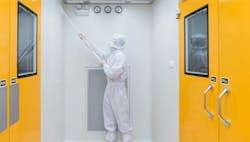When you consider the demands of pharmaceutical development — especially among small entrepreneurial organizations — it’s amazing that drugs come to market at all. Often it’s a testament to the tenacity of the scientist entrepreneur that an idea can take shape in a lab and make it even as far as clinical trials, let alone pharmacy shelves.
More than in any other business segment, however, pharma manufacturing is a race. The winner is the company that is fastest to market with life-saving medications and therapies. Speed to market is the sum total of speed of discovery, speed to clinical trials and speed of delivery.
The scientist entrepreneur — and startup pharma companies in general— are prepared for the discovery part of the equation. But then what?
Many are then faced with a choice: Build their own facilities or outsource their discoveries to CDMOs. In each case, the choice introduces additional challenges that may slow down the company’s effort to win the race.
Choosing the right path
If the company opts to build its own facility, it is immediately faced with the reality that the skills that got them to discovery are not the same as the skills demanded by Good Manufacturing Practices (GMP).
These entrepreneurs need clinical manufacturing capability, but may lack GMP and engineering expertise, and most may not have an adequate quality management system in place. They also will come to realize that “simple things,” like controlling and monitoring the environment, proper cleaning and material management may not be in the core competency of the company. Add to that the time required to design and build facilities, and this entrepreneur may be looking at two years or longer for the next stage of development. Due to funding and other issues, this is not time many startups have.
The entrepreneur wants a Fail/Forward decision first, and a leased cleanroom to produce clinical stage material is all that is required for that. So, what other paths are there?
Another alternative to building a facility may be CDMO outsourcing. But that path is snarled by the years-long backlog. According to a report from Bourne Partners, the average waiting time for CDMO capacity in 2019 ranged “from 16-24 months, resulting in customers buying slots in production queues years in advance.”
For a growing number of entrepreneurs, the middle ground between building a facility and outsourcing development may come in leasing out cleanroom space. This is an emerging trend, and all options are definitely not the same. In many cases an organization may receive just this: available leased space.
This is essentially the “life sciences real estate development” model. Warehouses, unused legacy pharma manufacturing space, and high rise buildings alike are being offered up this way. Developers inside biotech corridors tout their space as available for biotech startups, but few provide important support, facility management or consultative services.
Space alone does not bridge the gap in skills between the entrepreneur and the requirements of drug manufacturing and delivery. There is a serious need for “wrap-around services” that can ease the transition from lab to cleanroom and on to clinical trials. Models that address this gap, such as “cleanrooms on demand,” are coming successfully to market. This model is based on the services offered to supplement the leased cleanroom. You focus on the science while they focus on compliance.
Once an entrepreneur begins to walk the learning curve in this next phase of their business, there are many considerations:
Controlled material storage: Does the cleanroom facility have ambient, refrigerated and freezer storage? Ultra-cold storage? Cryogenics? Is the equipment qualified and monitored? Who maintains the equipment? What is the capability for alarm notification?
Material management: What are the policies related to material receipt, inspection, labeling and segregation? How is inventory managed?
Raw material sampling and testing: Is the facility capable of sampling under ISO 5 Biosafety Cabinet requirements? What are its capabilities for spectroscopy? Can it provide Raman ID or Fourier-transform infrared spectroscopy? Do you have laboratories in place for testing?
Despite all of these challenges, entrepreneurs and startup organizations persevere. It can be a difficult, courageous choice for the scientist entrepreneur to go outside their comfort zone, but it’s a necessary decision in the race to win in pharma manufacturing.






